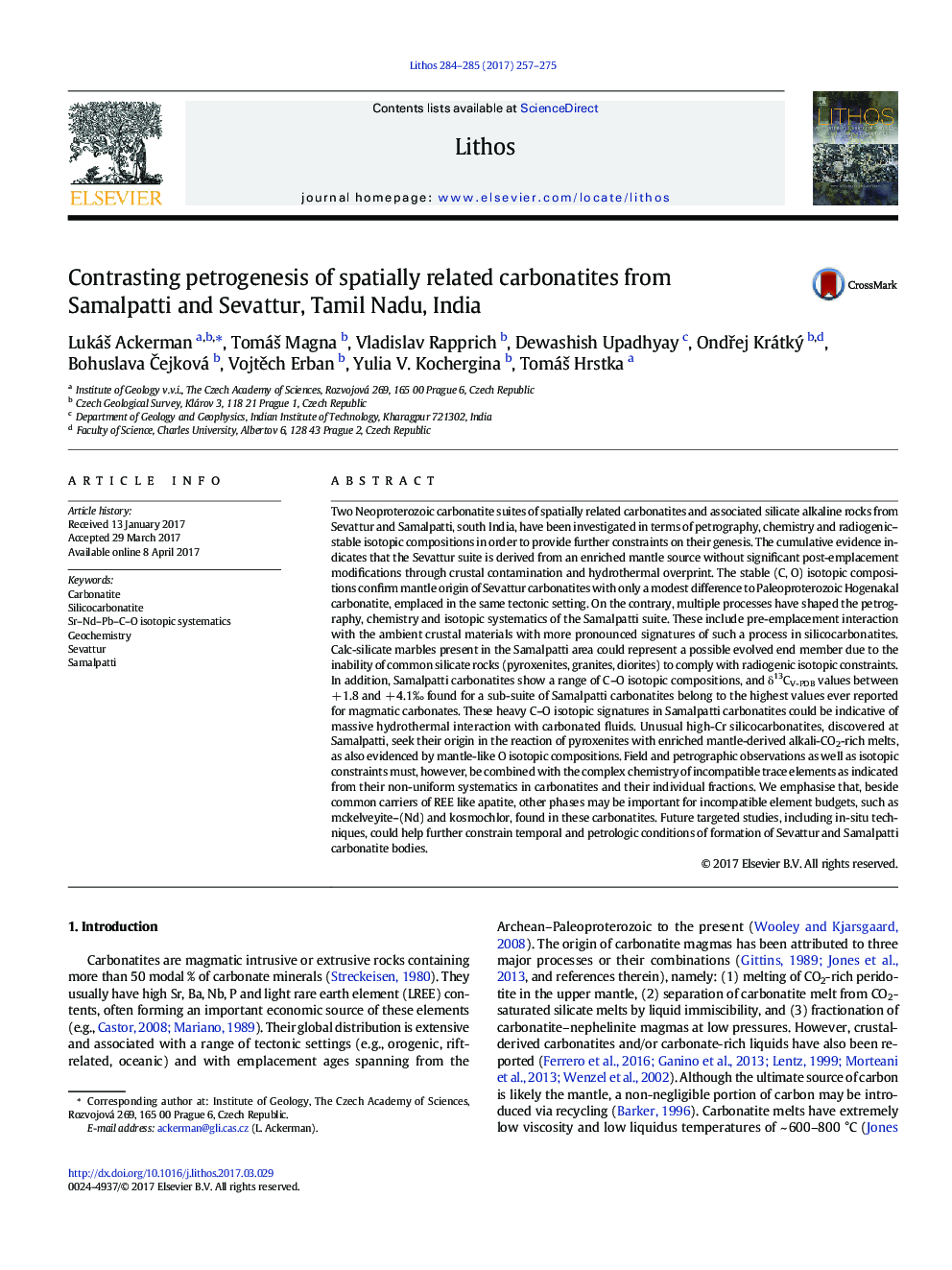| کد مقاله | کد نشریه | سال انتشار | مقاله انگلیسی | نسخه تمام متن |
|---|---|---|---|---|
| 5784041 | 1638630 | 2017 | 19 صفحه PDF | دانلود رایگان |
عنوان انگلیسی مقاله ISI
Contrasting petrogenesis of spatially related carbonatites from Samalpatti and Sevattur, Tamil Nadu, India
ترجمه فارسی عنوان
کنتراست پتروژنز کربناتیت های مربوط به فضایی از سامپلاتتی و ساتواتور، تامیل نادو، هند
دانلود مقاله + سفارش ترجمه
دانلود مقاله ISI انگلیسی
رایگان برای ایرانیان
کلمات کلیدی
موضوعات مرتبط
مهندسی و علوم پایه
علوم زمین و سیارات
ژئوشیمی و پترولوژی
چکیده انگلیسی
Two Neoproterozoic carbonatite suites of spatially related carbonatites and associated silicate alkaline rocks from Sevattur and Samalpatti, south India, have been investigated in terms of petrography, chemistry and radiogenic-stable isotopic compositions in order to provide further constraints on their genesis. The cumulative evidence indicates that the Sevattur suite is derived from an enriched mantle source without significant post-emplacement modifications through crustal contamination and hydrothermal overprint. The stable (C, O) isotopic compositions confirm mantle origin of Sevattur carbonatites with only a modest difference to Paleoproterozoic Hogenakal carbonatite, emplaced in the same tectonic setting. On the contrary, multiple processes have shaped the petrography, chemistry and isotopic systematics of the Samalpatti suite. These include pre-emplacement interaction with the ambient crustal materials with more pronounced signatures of such a process in silicocarbonatites. Calc-silicate marbles present in the Samalpatti area could represent a possible evolved end member due to the inability of common silicate rocks (pyroxenites, granites, diorites) to comply with radiogenic isotopic constraints. In addition, Samalpatti carbonatites show a range of C-O isotopic compositions, and δ13CV-PDB values between + 1.8 and + 4.1Ⱐfound for a sub-suite of Samalpatti carbonatites belong to the highest values ever reported for magmatic carbonates. These heavy C-O isotopic signatures in Samalpatti carbonatites could be indicative of massive hydrothermal interaction with carbonated fluids. Unusual high-Cr silicocarbonatites, discovered at Samalpatti, seek their origin in the reaction of pyroxenites with enriched mantle-derived alkali-CO2-rich melts, as also evidenced by mantle-like O isotopic compositions. Field and petrographic observations as well as isotopic constraints must, however, be combined with the complex chemistry of incompatible trace elements as indicated from their non-uniform systematics in carbonatites and their individual fractions. We emphasise that, beside common carriers of REE like apatite, other phases may be important for incompatible element budgets, such as mckelveyite-(Nd) and kosmochlor, found in these carbonatites. Future targeted studies, including in-situ techniques, could help further constrain temporal and petrologic conditions of formation of Sevattur and Samalpatti carbonatite bodies.
ناشر
Database: Elsevier - ScienceDirect (ساینس دایرکت)
Journal: Lithos - Volumes 284â285, July 2017, Pages 257-275
Journal: Lithos - Volumes 284â285, July 2017, Pages 257-275
نویسندگان
LukáÅ¡ Ackerman, TomáÅ¡ Magna, Vladislav Rapprich, Dewashish Upadhyay, OndÅej Krátký, Bohuslava Äejková, VojtÄch Erban, Yulia V. Kochergina, TomáÅ¡ Hrstka,
